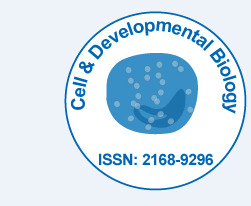
Cell & Developmental Biology
Open Access
ISSN: 2168-9296

ISSN: 2168-9296
Perspective - (2025)Volume 14, Issue 1
Organoids represent a revolutionary advancement in developmental biology research, providing three-dimensional, multicellular systems that recapitulate key aspects of organ development and function. These self-organizing structures, derived from pluripotent stem cells or adult tissue stem cells, exhibit remarkable similarity to their in vivo counterparts in terms of cellular composition, spatial organization, and developmental trajectories. The organoid technology has emerged as a powerful platform for studying human development, modeling diseases, and developing therapeutic interventions while addressing ethical concerns associated with embryo research.
The fundamental principle underlying organoid formation is the intrinsic self-organizing capacity of stem cells when provided with appropriate culture conditions. Pluripotent stem cells possess the inherent ability to differentiate into multiple cell types and organize into complex tissue structures through the recapitulation of embryonic developmental programs. The culture environment, including growth factors, extracellular matrix components, and mechanical constraints, guides this self-organization process by activating specific signaling pathways and transcriptional programs. The resulting organoids exhibit emergent properties that arise from the complex interactions between different cell types and their microenvironment.
Brain organoids, also known as cerebral organoids, have provided unprecedented insights into human neurodevelopment and neurological disorders. These structures recapitulate key aspects of early brain development, including neural tube formation, neurogenesis, and the establishment of brain regionalization. Cerebral organoids exhibit distinct brain regions with characteristic gene expression patterns and cellular compositions, including cortical layers with appropriate neuronal subtypes. The ability to generate organoids from patient-derived induced Pluripotent Stem Cells (iPSCs) has enabled the study of neurodevelopmental disorders such as autism, schizophrenia, and microcephaly in human cellular contexts.
Intestinal organoids have emerged as powerful models for studying gastrointestinal development and disease. These structures recapitulate the crypt-villus architecture of the intestinal epithelium and contain the major intestinal cell types, including enterocytes, goblet cells, paneth cells, and enteroendocrine cells. Intestinal organoids exhibit functional properties such as barrier function, nutrient absorption, and hormone secretion, making them valuable models for studying intestinal physiology and pathology. The ability to generate organoids from different intestinal regions has enabled the study of regional specification and the factors controlling intestinal development.
Hepatic organoids, or liver organoids, have provided insights into liver development and hepatocyte function. These structures contain hepatocytes, cholangiocytes, and other liver cell types arranged in tissue-like architectures. Liver organoids exhibit metabolic functions characteristic of mature hepatocytes, including albumin production, drug metabolism, and glycogen storage. The ability to generate functional hepatic tissue in vitro has important implications for toxicology testing, drug development, and potentially regenerative medicine applications.
Cardiac organoids have emerged as valuable models for studying heart development and cardiovascular disease. These structures contain cardiomyocytes, endothelial cells, and cardiac fibroblasts organized into chamber-like structures that exhibit spontaneous contractile activity. Cardiac organoids recapitulate key aspects of heart development, including chamber formation, electrical conduction system development, and the establishment of blood vessel networks. The ability to generate cardiac organoids from patient-derived iPSCs has enabled the study of inherited cardiomyopathies and the development of personalized therapeutic approaches.
Lung organoids have provided insights into respiratory system development and pulmonary diseases. These structures recapitulate the branching morphogenesis characteristic of lung development and contain the major lung cell types, including alveolar epithelial cells, airway epithelial cells, and pulmonary endothelial cells. Lung organoids exhibit functional properties such as surfactant production and gas exchange capacity, making them valuable models for studying respiratory physiology and pathology. The recent application of lung organoids to study COVID-19 has demonstrated their utility for infectious disease research.
Kidney organoids have emerged as important models for studying nephron development and kidney disease. These structures contain the major kidney cell types, including podocytes, tubular epithelial cells, and endothelial cells, organized into nephron-like structures. Kidney organoids exhibit functional properties such as filtration and urine production, although they do not achieve the full complexity of mature kidneys. The ability to generate kidney organoids from patient-derived iPSCs has enabled the study of inherited kidney diseases and the development of potential therapeutic interventions.
The integration of organoid technology with other advanced techniques has enhanced their utility for developmental biology research. Live imaging of organoids has provided insights into the dynamic processes of tissue morphogenesis and cellular behavior. Single-cell RNA sequencing of organoids has revealed the cellular heterogeneity and developmental trajectories within these structures. The combination of organoids with microfluidic devices has enabled the creation of organ-on-chip systems that better recapitulate the physiological environment of organs.
Organoids have emerged as transformative tools for developmental biology research, providing accessible models for studying human development and disease. These self-organizing structures recapitulate key aspects of organ development and function, enabling detailed investigations of developmental processes that would be impossible to study in human embryos. The ability to generate organoids from patient-derived cells has opened new avenues for personalized medicine and drug development. As organoid technology continues to advance, we can expect even more sophisticated models that better recapitulate the complexity of human organs and provide deeper insights into developmental biology and disease mechanisms.
Citation: Aaron M (2025). Organoids as Models for Human Developmental Biology. Cell Dev Biol. 14:386.
Received: 03-Mar-2025, Manuscript No. CDB-25-38142; Editor assigned: 05-Mar-2025, Pre QC No. CDB-25-38142 (PQ); Reviewed: 19-Mar-2025, QC No. CDB-25-38142; Revised: 26-Mar-2025, Manuscript No. CDB-25-38142 (R); Published: 02-Apr-2025 , DOI: 10.35248/2168-9296.25.14.386
Copyright: © 2025 Aaron M. This is an open-access article distributed under the terms of the Creative Commons Attribution License, which permits unrestricted use, distribution, and reproduction in any medium, provided the original author and source are credited.